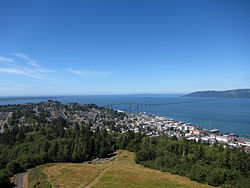Astoria, Oregon
| Astoria, Oregon | ||
|---|---|---|
| City | ||

Astoria and the Astoria–Megler Bridge
|
||
|
||
 Location in Oregon |
||
| Location in the United States | ||
| Coordinates: 46°11′20″N 123°49′16″W / 46.18889°N 123.82111°WCoordinates: 46°11′20″N 123°49′16″W / 46.18889°N 123.82111°W | ||
| Country | United States | |
| State | Oregon | |
| County | Clatsop | |
| Founded | 1811 | |
| Incorporated | 1876 | |
| Government | ||
| • Mayor | Arline J. LaMear (D) | |
| Area | ||
| • Total | 10.11 sq mi (26.18 km2) | |
| • Land | 6.16 sq mi (15.95 km2) | |
| • Water | 3.95 sq mi (10.23 km2) | |
| Elevation | 23 ft (7 m) | |
| Population (2010) | ||
| • Total | 9,477 | |
| • Estimate (2012) | 9,527 | |
| • Density | 1,538.5/sq mi (594.0/km2) | |
| Time zone | PST (UTC-8) | |
| • Summer (DST) | PDT (UTC-7) | |
| ZIP code | 97103 | |
| Area code(s) | 503 and 971 | |
| FIPS code | 41-03150 | |
| GNIS feature ID | 1117076 | |
| Website | www.astoria.or.us | |
Astoria is the seat of Clatsop County, Oregon, United States. Situated near the mouth of the Columbia River, the city was named after the American investor John Jacob Astor. His American Fur Company founded Fort Astoria at the site in 1811, 206 years ago. Astoria was incorporated by the Oregon Legislative Assembly on October 20, 1876.
It holds the distinction of being the first permanent United States settlement on the Pacific coast and for having the first U.S. post office west of the Rocky Mountains.
Located on the south shore of the Columbia River, the city is served by the deepwater Port of Astoria. Transportation includes the Astoria Regional Airport with U.S. Route 30 and U.S. Route 101 as the main highways, and the 4.1-mile (6.6 km) Astoria–Megler Bridge connecting to neighboring Washington across the river. The population was 9,477 at the 2010 census.
The Lewis and Clark Expedition spent the winter of 1805–06 at Fort Clatsop, a small log structure south and west of modern-day Astoria. The expedition had hoped a ship would come by to take them back east, but instead they endured a torturous winter of rain and cold, later returning the way they came. Today the fort has been recreated and is now a historical park.
In 1811, British explorer David Thompson, the first person known to have navigated the entire length of the Columbia River, reached the partially constructed Fort Astoria near the mouth of the river. He arrived just two months after the Pacific Fur Company's ship, the Tonquin. The fort constructed by the Tonquin party established Astoria as a U.S., rather than a British, settlement. It became a vital post for American exploration of the continent and was later used as an American claim in the Oregon boundary dispute with European nations.
...
Wikipedia


